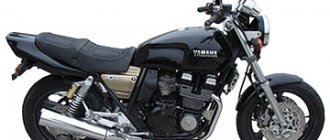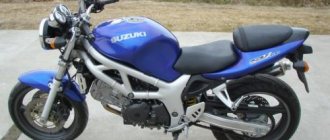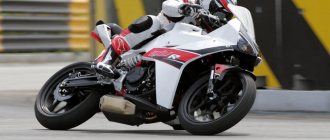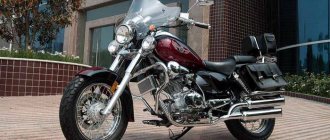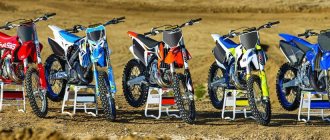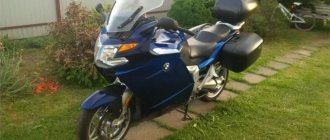UNIVERSAL SOLDIER – II
or
Suzuki GSX 1400 LOOK WITHOUT EMOTIONS
WHO ARE YOU?
Classifying, and especially comparing, motorcycles is a thankless task. Everyone has their own view and tastes. Each man has his own character, knowledge and sensations of what he has between his legs. I mean the feel of the bike, of course! In order, first of all, to fully understand it myself, and maybe let anyone who is interested understand what the Suzuki GSX1400 is, I decided to start this analysis with history, so to speak, with a pedigree.
It so happened historically that a motorcycle with an open appearance, a frame, a straight seat, and with “average” suspension travel subsequently began to be called classic. Everything ingenious is simple. Simpler means there are fewer intermediate links, intermediaries and all sorts of bells and whistles, which means there is less likelihood of all this extra failure, which means everything in general is much more reliable - there’s simply nothing to break! Maybe at that time it was easiest to make a motorcycle with just such a layout so that he could ride? In the future, civilization and restless minds “screw up” the existing basis (classics) or change the basis itself. Something happens out of necessity due to greater demands that have arisen, some from a flight of thought, and some from the evil one... I think that the ideas of designers, technological progress, the influence of fashion and necessity began to transform the original version of motorcycles, called classic, into other types of motorcycles: they did greater fork angle, lower seating position, added style and the result was the legendary chopper; They increased the suspension travel, lightened the motorcycle - and a genus of “jumping” and “climbing” enduro and motocross motorcycles began to take shape. By concentrating on speed and maneuverability, making the fork tilt almost vertical for greater control sensitivity, neglecting the comfort of landing due to design necessity and for the sake of achieving the goal, the image of modern sportbikes began to take shape. The transformation, of course, achieved its goals, and today we have a large range and many breeds of interesting two-wheeled horses with motors. The difference is so great that it is difficult to believe in the relationship, for example, of the Suzuki Hayabusa, which can easily overcome the barrier of 300 km/h, and a trial motorcycle, without a saddle at all, which, in skillful hands and feet, can jump from a place literally above its head and climb vertical walls!
Despite the conservative appearance and the layout that has been established for decades (in my opinion, this has its undoubted advantages - it has been time-tested not only in control, but also in operation...), technically the Suzuki GSX1400 is, of course, a child of its time. Beneath the classic appearance lies a modern “heart” - an improved version of the legendary engines from the Suzuki GSX-R1100 and Suzuki Bandit 1200, which, in addition, used a unique and time-tested concept of air-oil cooling: oil used for both lubrication and cooling At the same time, it’s a brilliant idea. In this case, the oil, passing through the oil cooler, is cooled and does not overheat, does not coke, and retains its lubricating physical and operational characteristics longer. By comparison, liquid water or air cooling only cools the engine, leaving the oil essentially warm. Of course, the oil is also cooled in these cases, but this occurs with a much greater time delay and is not as effective as direct cooling of the oil through an oil cooler. The air-oil engine cooling system developed by Suzuki specifically for motorcycles allows cooling not just the oil from the engine crankcase, but also the cylinder walls, as is the case with water cooling, because The oil circulates through special grooves inside the engine, and the motor walls have attractive and stylish-looking air cooling fins. Motors of this design are incredibly reliable and have enormous potential for tuning. It is almost impossible to imagine a pirouette when this engine would be in an oil starvation situation. That is why motorcycles with such engines are popular among tuners and stunt riders who ride for hours on the rear wheels in extreme conditions.
So, in the chest of the Suzuki GSX1400 there is a truly fiery engine. It is also important and pleasant that this engine is currently the largest of all in-line “fours” mass-produced in the motorcycle world. So, “from the heart” everything is clear. What about other places? What do other organs look like and what can they do? Everything is at its best! The GSX1400 has a serious set of undeniable advantages.... That's it! Probably, we need to be calmer and pay more attention to facts and figures, preferably time-tested! Let's look at our surroundings without emotions!
Description
The classic motorcycle model Suzuki GSX 1400 begins its history in 2001 and is produced until 2008. The appearance of this motorcycle on the market was due to Suzuki’s desire to have a flagship representative among the “classics” of large capacity. The model was based on a specially designed air-oil-cooled injection engine with a volume of 1402 cc. see, producing 106 hp. power and 125 Nm of torque. The engine does not have high speeds, has powerful torque at the bottom and produces maximum performance from 5000 to 6800 rpm.
FACTS and COMPARISONS
Indeed, in order not to be unfounded, it is necessary to present the facts. And it’s even better when the facts can be compared. Motorcycles that are classmates for the SUZUKI GSX1400 in spirit and form are the Honda CB1300, made on the basis of the Honda X4 Type LD, as well as the Yamaha XJR1300. I propose to collect the characteristics and data of the above-mentioned motorcycles into one table and carefully consider and compare everything (data taken from manufacturers’ catalogs for actually produced models and Internet sources):
Specifications and comparisons:
| Yamaha XJR 1300 | Honda CB 1300 | SUZUKI GSX 1400 | My conclusion | |
| 4-stroke, 4-cylinder, in-line, 16-valve, DOHC | 4-stroke, 4-cylinder, in-line, 16-valve DOHC | 4-stroke, 4-cylinder, in-line, 16-valve DOHC. | Fundamentally similar inline engine designs, with modern overhead camshafts and other details | |
| WORKING VOLUME CYLINDERS | 1251 cm3 | 1284 cm3 | 1402 cm3 | 1402 cm3 is a number, anyway! |
| CYLINDER DIAMETER x PISTON STROKE: | 79.0 x 63.8 mm | 78 x 67.2 mm | 81.0 x 68.0 mm | The SUZUKI GSX1400 has a more “flexible” engine, not only because of its larger displacement... |
| COMPRESSION RATIO: | 9,7:1 | 9,6:1 | 9,5:1 | The low compression ratio of 9.5 in practice means that the SUZUKI GSX1400 is unpretentious to gasoline. This is very convenient in our conditions |
| SUPPLY SYSTEM: | 4 carburetors Mikuni BS3 6×4, | Injection | Injection | Few motorcycles can boast of injection, even in our time. |
| COOLING | Air-oil | Liquid | Air-oil | Air-oil cooling is still holding its own |
| POWER | 106 hp at 8000 rpm | 116 hp 85 kW at 7000 rpm | 106 hp at 6800 rpm | While losing a little in maximum power, the GSX 1400 has more power at low and mid-range speeds, which is more convenient in practice. |
| TORQUE | 100 Nm at 6000 rpm | 117 Nm at 6000 rpm | 126 Nm at 5000 rpm | The torque is not only greater than others, but it also occurs at lower revs and its curve is the flattest, which in practice means economy and ride comfort. |
| TRANSMISSION | 5-speed | 5-speed | 6-speed | The GSX1400's sixth gear allows it to save fuel during suburban driving. |
| STEERING COLUMN TILT ANGLE: | 25,5° | 25,0 (31,0)° | 26,0° | The XJR and CB have slightly sharper handling, but it's all subtle. These motorcycles are not for the track anyway! |
| FRONT SUSPENSION: | Telescopic fork, stay diameter 43 mm, stroke 130 mm | Telescopic fork, blade diameter 43 mm, stroke 120 mm | Adjustable telescopic fork, stay diameter 46 mm, travel 120 mm | The thickest GSX1400 fork ensures greater stability and torsional linearity. |
| REAR SUSPENSION: | Two shock absorbers with spring preload adjustment, 110 mm travel | Two shock absorbers with adjustable spring preload, 116 mm travel | Dual shock absorbers with adjustable spring preload and rebound damping, 130 mm travel | Fully adjustable suspension on the GSX1400, and even without a key - they are fully adjustable in Africa too! |
| FRONT TIRE: | 120/70 ZR17 | 120/70 ZR17 | 120/70 ZR17 | Standard, and only |
| REAR TIRE: | 180/55 ZR17 | 180/55 ZR17 | 190/50 ZR17 | This is the can of the GSX1400! Nice to see. You won't see such rollers on all cars! |
| BASE: | 1500 mm | 1515 mm | 1520 mm | A longer wheelbase means a more comfortable ride. We have many different roads |
| LENGTH x WIDTH x HEIGHT: | 2.175 x 780 x 1.115 mm | 2220 x 790 x 1120 mm | 2160 x 810 x 1140 mm | Each body has its own size and proportions. Try it on. |
| SEAT HEIGHT: | 775 mm | 790 mm | 790 mm | Each body has its own size and proportions. Try it on. |
| DRY MASS: | 230 kg | 226 (249) kg | 228 kg | I'm telling you they're twins. A couple of kilos back and forth is not a conversation. Don’t forget about the weight of the bikers themselves, which vary quite a lot |
| FRONT BRAKE: | Double disc, diameter 298 mm 4-piston calipers | Double disc, diameter 310 mm 4-piston calipers | Double disc, diameter 320 mm 6-piston calipers | The fast moving mass and the force of acceleration must be stopped reliably and with a margin of safety! Six pistons are not four! Plus a larger diameter brake disc. |
| REAR BRAKE: | Single disc, diameter 267 mm, two-piston caliper | Single disc, diameter 256 mm, single-piston caliper | Single disc, diameter 220 mm, two-piston caliper | Be careful with the rear brake! Remember that in practice this is a maximum of 10% of the overall braking dynamics of the motorcycle. Under normal conditions, the rear brake is used for correction, not braking! |
| FUEL TANK CAPACITY: | 21 l | 21 l | 22 l | The stock is too much for your pocket! Who said that an extra liter is not needed? |
| real ECONOMY | City ~ 6 l/100 km Highway speeds up to 130 km/h ~ 5 l/100 km Highway speed from 150 km/h ~ 8-10 l/100 km | I do not provide fuel consumption data for other motorcycles, because I believe that fuel consumption is an expression of driving temperament. I have not used either the CB1300 or the XJR1300 for a long time to personally measure these indicators based on my riding style, and on the Internet you can find completely different data from different owners. In any case, I think the consumption is about the same. On the other hand, is it really a pity to eat oats for a beloved horse that gives SUCH pleasure? | ||
| GROUND CLEARANCE | 120 mm | 135 mm | 130 mm | This is not an enduro, but you can drive up fairly high curbs or steps |
| CENTER STAND | There is | No | There is | The CB1300 is certainly a worthy bike and contender. It is strange that it does not have such a necessary and convenient thing in this class of motorcycles as a central stand. Maybe if they added it, the GSX1400 would win the argument for less weight?! J. It would be better if they added it - a very useful thing! An extra couple of kilograms will not spoil a man who knows his virtues! |
Let's summarize the numbers and comparisons. The proud owner of a SUZUKI GSX1400 can truly claim that his motorcycle has the largest inline four-cylinder engine among mass-produced motorcycles, with one of the highest torque values. If necessary, the driver will be able to manually adjust the suspension faster and easier than all his classmates depending on the load of the motorcycle, road conditions and the desired pace and riding style. The motorcycle borrowed its six-piston front brake calipers from one of the best sportbikes of our time - SUZUKI GSX-R1000. There is a fairly large tank, larger than that of its classmates. There is a six-speed gearbox, not five. This motorcycle is equipped with a center stand, and the owner does not need to ask anyone for help when lubricating the chain, tightening it or other work. And in the parking lot, on the center stand, you can even... dance on a motorcycle, that's it! What is especially pleasing is that the motorcycle is not picky - it will gobble up almost any gasoline from 91 and above and will not wince, and will ride just as powerfully and quickly (just do not fill up with diesel or Gasoline), accelerates to 100 km/h in just 3 seconds, and up to 200... well, also very fast. Faster than the vast majority of other equipment!
Brief history of the model
2001 - production and sales of the Suzuki GSX 1400 model began. The motorcycle is available only in Japan and Australia. Model: Suzuki GSX1400 (Japan, Australia). Factory designation: GSX1400K1.
2002 - the model is delivered to Europe. Model: Suzuki GSX1400 (Japan, Australia, Europe). Factory designation: GSX1400K2.
2003 - the model is equipped with an immobilizer. Model: Suzuki GSX1400 (Japan, Australia, Europe). Factory designation: GSX1400K3.
2004 - Release of a specially limited edition GSX1400 in GS1000 colors. Model: Suzuki GSX1400 (Japan, Australia, Europe). Factory designation: GSX1400K4.
2005 - the model undergoes changes. The 4-2-2 exhaust changes to a 4-2-1 (single tailpipe), which reduces the dry weight of the bike slightly. The injector settings have been changed to improve low-end thrust and improve fuel efficiency. The engine cylinders are now coated with SMEC - Suzuki Composite Electrochemical Material. The front brake lever is adjustable in 5 positions (instead of 6). Special versions appear: black for Europe (has red rear suspension springs like the Japanese versions) and GSX1400Z for Japan (features gold wheels, black engine and black exhaust). The Suzuki emblem on the gas tank changes to an "S". Model: Suzuki GSX1400 (Japan, Australia, Europe). Factory designation: GSX1400K5.
2006 - With updated emissions regulations in some European countries, the GSX1400 was announced to end production and sales, but the bike was still available in the UK. Model: Suzuki GSX1400 (Japan, Australia, Europe). Factory designation: GSX1400K6.
2007 is the final year of production for the European market. Model: Suzuki GSX1400 (Japan, Australia, Europe). Factory designation: GSX1400K7.
2008 is the last year of production in the Japanese market and for Australia. To top it off, Suzuki is releasing a limited edition Special Edition motorcycle in blue, white and light blue colours. Model: Suzuki GSX1400 (Japan, Australia). Factory designation: GSX1400K8.
Suzuki GSX 1400
motorcycle is a bright representative of the cubic “classics”.
The numbers in its name clearly hint at the impressive engine capacity, as well as the fact that without solid driving experience behind you, you shouldn’t get on it - it’s dangerous. This bike was produced from 2001 to 2008, and although it is very similar to the famous “Bandits” line, it stands apart from it. However, there are some similarities with the Suzuki GSF 1200 in its naked version. The similarity with the “Bandits” is not accidental - the GSX 1400 is also equipped with a steel frame and a similar 4-cylinder air-oil-cooled engine, although instead of carburetors it is powered by an injector. Its power is low, only 106 hp. and 125 Nm of torque, which, you see, is quite a bit for such an engine. For comparison, on the Suzuki GSX 1300R, with a comparable engine size, the power is under 200 hp. But the derated GSX1400 motor has a truly inexhaustible resource.
Another difference from the 1200 cc Bandit is a 6-speed gearbox instead of a 5-speed one. Otherwise, these motorcycles are very similar, even in appearance. The front brakes on the Suzuki GSX 1400 are also similar to those on the GSF 1200 - six-piston calipers mounted on 310mm discs up front. The dynamics of both motorcycles are similar, the GSX 1400 has a top speed of 235 km/h and accelerates from 0 to 100 km/h in 3.2 seconds. However, the hero of our article is distinguished from the “Bandit” by the smoother nature of the engine and even more powerful traction at the bottom, reminiscent of the Honda CB 1300. Other competitors in the same class, however, are no less popular - the Yamaha XJR 1300, for example, and the Kawasaki ZRX1200.
Externally, the Suzuki GSX 1400 is built according to all the canons of the classic style. A round headlight, an instrument panel on the steering wheel, a one-piece seat... There is nothing unusual or deliberately modern in its appearance, but that’s what’s good about it. For lovers of modern technology, there are already enough motorcycles on sale that meet their needs; one Yamaha MT-09 is worth it, or a Honda CB1000R. And this Suzuki has its own charisma, it is a real “iron” bike for lovers of the good old style, uncompromising, powerful, durable and extremely reliable.
The motorcycle turned out to be quite simple from a technical point of view, and it is distinguished by its impressive weight and decent seat height (almost 230 kg and 79 cm, respectively), and the fairly high center of gravity makes the Suzuki GSX 1400 subjectively very heavy indeed. At the very least, a cruiser that weighs a hundred kilograms more with a lower center of gravity seems subjectively noticeably lighter, so short and skinny riders should think twice before turning their attention to the GSX 1400.
However, this model was never aimed at them, or simply at beginners. The typical owner of such a motorcycle is an experienced biker, strong enough to handle the motorcycle while moving it in a parking lot, and calm enough not to demand racing feats from the deformed “classic.” No, the dynamics of this bike are simply explosive, and it is capable of a lot, but still it is a fairly comfortable classic motorcycle, and not a racing vehicle. Speaking of comfort, it is very comfortable for a tall person to sit on the Suzuki GSX 1400. Verified. And its suspensions are softer than those of the Bandits, and also have a full range of adjustments.
Fans of high-tech bells and whistles, various engine management modes and traction controls will most likely pass this motorcycle up. But those who like only harsh hardware with a minimum of electronics and other complications will appreciate the GSX 1400. This is a truly great bike.
Similar articles:
- Review of Suzuki VS 1400 Intruder
- Review of Suzuki GSF 1250 Bandit
- Kawasaki ZZR 1400 review
- Review of Suzuki VL Intruder 1500 LC
- Review of Suzuki GSF 600 Bandit
- Kawasaki ZRX 1200 Review
LiveJournal
Specifications
| Model | Suzuki GSX1400 |
| Motorcycle type | road (street, classic) |
| Year of issue | 2001-2008 |
| Frame | steel tubular |
| engine's type | 4-cylinder, 4-stroke, in-line |
| Working volume | 1402 cm³ |
| Bore/Stroke | 81.0 x 68.0 mm |
| Compression ratio | 9.5:1 |
| Cooling | air-oil (SACS - Suzuki Advanced Cooling System) |
| Number of valves per cylinder | DOHC, 4 valves per cylinder |
| Fuel supply system | Injector with SDTV (Suzuki Dual Throttle Valve), 4x 34 mm |
| Ignition type | transistor |
| Maximum power | 100.0 hp (74.0 kW) at 6500 rpm – GSX1400 (Japan) 106.0 hp (78.0 kW) at 6800 rpm – GSX1400 (Europe, Australia) |
| Maximum torque | 126 Nm (12.7 kg*m) at 5000 rpm – GSX1400K1-K4 124 Nm (12.5 kg*m) at 5000 rpm – GSX1400K5-K8 |
| Transmission | 6-speed |
| type of drive | chain |
| Front tire size | 120/70 ZR17 (58W) |
| Rear tire size | 190/50 ZR17 (73W) |
| Front brakes | 2 discs, 320 mm, 6-piston calipers |
| Rear brakes | 1 disc, 260 mm, 2-piston caliper |
| Front suspension | 46 mm telescopic fork (adjustable), travel - 130 mm |
| Rear suspension | pendulum with two shock absorbers (adjustable), stroke - 123 mm |
| Motorcycle length | 2160 mm |
| Motorcycle width | 810 mm |
| Motorcycle height | 1140 mm |
| Wheelbase | 1520 mm |
| Seat height | 790 mm |
| Minimum ground clearance | 130 mm |
| Acceleration to 100 km/h | 3.2 sec |
| Maximum speed | 240 km/h |
| Gas tank capacity | 22.0 l |
| Motorcycle weight (dry) | 228 kg – GSX1400K1-K4 225 kg – GSX1400K5-K8 |
Review of the Suzuki GSX 1400 motorcycle
As a rule, such motorcycles are not bought by people from children's homes. They say that it is for “old people”. Not true. Although there are better motorcycles for searching for adventures, or rather for getting your butt hurts. The motorcycle interested me with its purely classic appearance, impressive engine, good brakes and suspension. It is very well suited for everyday use, for driving around the house and for traveling. It is light for its class, however, while somehow pulling it out of a muddy puddle (sometimes), I bent the steering wheel with my hands, but it never moved. It steers very well at low speed, you can skid to a stop like a moped in the dust without fear of tipping it over. Many times he forgave me for something that Bandit, for example, wouldn’t allow. Not prone to wobbling and wobbling. Stable at 180 like the SB1000 at 120. The brakes are really good and you can feel it at speed. The rear one is just for show, but it copes with the stretching of the motorcycle during heavy braking. I am light (65 kg) rear amm. adjustments. It’s not enough - it’s too stiff and the motorcycle doesn’t seem to feel me. The fork works well. The seat is not double but triple. There is a huge glove compartment underneath. It will fit 2 one-and-a-half-barrel bags, a raincoat, a spider, and other little things. I drove 350 km. non-stop and at the same time not tired at all. The seat is also very comfortable for the passenger and the motorcycle rides more confidently with it.
The motor is a separate issue. It can be compared to an elevator or an electric train. No dips or catches. (That's why not everyone understands the bike) It's off... It's a goat with gas from 2500. It also wears out the tires very quickly. Excellent engine braking even in 6th gear. In the rain it can probably slip at any speed from light throttle application, so it's necessary be more delicate. I can’t measure the acceleration to 100, but to 160 - until the end of the house, as friends say. It is laid shallowly and reluctantly. It eats equally well in both 92 and 95, while the consumption is 7.5 liters in any city, 130, or 200. The maximum speed is 245 according to the speedometer. Together 230.
I can’t say anything about repairs - the motorcycle is quite new and has not broken down. The costs were as follows: gasoline, oil 4.5x6000 km, filter, pads in front 2 pairs X 15000. rear tank X 8000, front tank X 12000.
In general, the motorcycle is specific and despite 1400 cubic meters it can be classified as a liter both in terms of power and everything else. Only he is better...
P.S. I hope someone finds this article useful and helps them make the right choice.
P.S.2 was not mistaken about safety: after the frontal with a chisel (70-80 + my 130-150), the gsx remained like a motorcycle, but the rear doors of the vase didn’t even open... and I’m alive! The story of this motorcycle has ended.
Pych (Suzuki GSX1400) is my second serious motorcycle, before it there was Chok (Yamaha XJR1300), which I rode only a couple of thousand km and had an accident on April 19, 2014, they didn’t let me through at an intersection. He himself escaped with a slight fright and shabby equipment, but he sold the motorcycle at a profit to the insurance company and began looking for a new one. At first, I wanted to buy a Chok again, I really liked it, a simple, reliable, cheap-to-maintain motorcycle, and at the same time I was looking at alternative options, but in this class, there weren’t any decent Chokes on sale at that time for reasonable money. In general, the 1300 cc Choka scared me at first, it was my first motorcycle, not counting the Owl as a child, but it turned out to be very friendly and easy to control, after 2000 km I realized how pleasant it is to ride “in the moment” and I no longer wanted less volume . I was looking through the advertisements, waiting for payment from the insurance company, in our city there was a Kawasaki ZRX 1200 for sale, not damaged, not painted, very decent in appearance, it took a ride - not my thing, it steers disgustingly and doesn’t go, even though it’s more powerful than Choka. A new Pych, 2004, complete Akrapovich, and many other cool little things appeared on sale, such as carbon linings on the lids, a zero filter, some kind of tuning thing for the ignition, for a lot of money, a comfortable saddle, etc. I went to look at it, took it for a ride, was pleasantly surprised, it steers better than Choka, went out on the highway, doesn’t shake anything, drives straight, behaves stably when braking. In general, I took it, it was May 31, like Chok, I took the first one I looked at. A few days later I re-registered, because I couldn’t do it earlier due to work, I got insurance and started riding. Over the rest of the season I drove 10 thousand, visited places I had never been before, went on a mini-long trip to Latvia, to a fest (the event is called Rust Weekend, I really liked it, I’ll go again), to Pärnu for the closing ceremony and many other places in Estonia. To maintain, the Pych is more difficult and more expensive than Choka, the oil in the engine is 4.6 liters, to adjust the valves you need to remove the shafts, the fuel filter is installed in the tank, it costs a lot of money (about 200 euros) and there is no alternative to it, only the collective farm or the original. The front calipers are six-piston, they brake no better than the four-piston Chokovsky ones, but the pads and repair kits are more expensive, the caliper bolts rust and need to be replaced. In the suspension, the spring preload and hydraulics are adjusted, now it’s a little harsh, but I haven’t touched it, I’m afraid the handling will deteriorate, I really like the way Pych rolls into turns, I often just cut circles on the rings, which have been tuned quite a lot lately. Pych has very low fuel consumption, on the highway, at a speed of 100-120 km/h, it does not exceed 5.5 liters, I don’t drive faster, for exceeding 20-40 km/h the fine is 200-400 euros, and from the new year it will be even more, for exceeding 40 km/h you can get several days of arrest. Dynamics, it is there, with such a volume it cannot but be there, Pych starts driving from 2500 rpm and up to 7000, it is useless to turn further, although it spins up to 9000 rpm. Pych is an excellent motorcycle, thanks to the huge torque, it is very pleasant to ride, you don’t have to constantly change gears, from 50 to 250 it goes to sixth, like an automatic machine, if necessary, you can leave the traffic light first, very few motorcycles can compete with it up to a hundred , while they are spinning up, Pych is already driving, 100 N*m at 3000 rpm, maximum 126 at 5000.
Design, quality of finish.
Almost everything is OK here. In general, I received a motorcycle in very good external condition. Mileage of 17 thousand. was very similar to the truth. Even very minor scratches and abrasions need to be looked for. The paint quality is no worse than Honda. The only disappointment was the engine exhaust pipes; spots of rust appeared on them. It feels like these pipes are not from this motorcycle at all, because... Then the exhaust and mufflers are just perfect. But on a 16-year-old CB, the pipes are like yesterday from the factory - the nickel on it is clearly better.
The motorcycle looks very powerful in real life. Two mufflers are ready to compete in size and beauty with those of the legendary Honda X4. A sharp tail with a modern brake light adds dynamics to the silhouette. The motor is painted black, which slightly masks its physical dimensions. The front brake discs with a diameter of 320 mm add solidity. with 6-piston calipers, a wide tank and a 200 rear tire. The size of the saddle is captivating - its total length is 10 cm longer than that of the SV1000. But the original saddle upholstery is simply terrible, so I immediately ordered its rework from Master Ilya Biker, which he successfully accomplished.
Comfort and suspension
I am 183 cm tall and weigh 95 cm very well on this motorcycle. The landing is lower than on the SV1000. That one has a higher saddle and a lower handlebar - you sit like in a sport car. Ilyukha also lowered the saddle by 1 cm. The brake/clutch lever adjustments are in the minimum positions, the steering wheel is tilted back as much as possible. In general, a motorcycle for big people. I would especially like to note the driver’s footrests on rubber silent blocks and the passenger’s footrests with rubber pads. The vibrations from the engine are rather less than those of the SV1000-balance shaft, and this engine operates at lower speeds.
I really liked the pendant. Very energy-intensive rear shock absorbers and fork. This does not take into account that everything is regulated in 3 directions. The SV1000 is just cotton wool, especially the rear shock absorbers.
Engine and gearbox. Fuel efficiency.
In general, a person quickly gets used to everything. I got used to this engine too. When I rode this motorcycle for the first time in Vladimir, I really liked it - it was just very smooth and very powerful traction from 1500 rpm even in 6th gear. 2000 rpm is already an absolutely normal mode for him - he begins to pull away from the steering wheel even in top gear. In general, it begins to accelerate quite confidently from 1000 rpm in 6th, all the way up to 6500, and this is already about 220 km/h according to GPS. Moreover, a couple of times I accidentally brought it to the point where at 6th the revolutions dropped below XX to 800 rpm... in principle, the engine was not very smooth, but it worked and was not going to stall. In general, an “electric motor”. So, I quickly got used to it, everything became self-evident. After a couple of thousand driving a GSX1400, I rode my CB1000. The first feeling is that I’m driving 400! In order to somehow accelerate the engine, you need to turn it up to 5 thousand! Later I am a couple of tens of km. took a ride on the FJR1300... Awww! Where does it have 1300 cc and 145 hp??? According to my narrow concepts, the engine of the Fougere begins to come to life only at 4.5 thousand. rpm I'm just disappointed. Lies! No there is 145 hp. And this is not just my opinion. Or they are in the unattainable skies. And I also wanted to buy this wine glass by taking out a loan. Uff... It's gone. But the glass is on an electric motor... To be fair, I will say that the Fougere will still be a little faster at maximum speed due to streamlining.
The negative side of such engine characteristics is the short life of the rear tire: the new Dunlop D208 200/50-17 lasted me only 8500 km... :sad00000: This is despite the fact that I don’t anneal or “goat”, but just drive. Colleagues write that Dunlop Roadsmart generally dies at this point after 6000 km. Hmmm... This doesn't make me happy at all.
But the mechanical noise from the motor is slightly greater than that of the SV1000. If you slightly cover the muffler of a CB with your hand, then you will hardly hear any mechanical noise from the engine, just a slight rustling sound, cool! But the Susa... No, it also seems to work without much knocking - only the timing belt can be heard, especially in the first few seconds when you start it hot. But here it stands, warming up... The revolutions are about 2000. And then a quiet “Clink!” And then it works... Then a slightly vague “Tynts!” :shok0000: somewhere under the engine... As a person accustomed to the SV1000, at first I grabbed the Validol. Then I gave up on it, and my colleagues calmed me down. In general, it’s normal for an air-oil-cooled engine.
Speaking of cooling. Everything is fine here too. After a while, I generally stopped understanding why antifreeze, a pump, hoses, etc. were needed. The system has two pumps. One drives oil through the radiator to lubricate the bearings, and the second through a separate line supplies oil to the cylinder head for cooling. Plus a huge oil cooler. Plus a fan on this radiator. In general, even in Krasnodar traffic jams at +32-35, this fan never turned on. That is, the oil temperature never reached 120 degrees. By the way, you need to check the fan and thermostat...
Very nice box. I expected the worst. I have never had any problems finding neutral. Shifting is a little worse than on the SV1000. Especially from 1st to 2nd there is some kind of two-way shifting, not “click”, but “click-click”. But this is in soft sneakers. You don't notice this in motorcycle boots. I admit that the SV1000 gearbox strives for the ideal. But I have 6 gears. In sixth at 4000 rpm the speedometer shows exactly 140! This is my favorite mode outside the city. True, the real speed according to GPS is 128 km/h, but all speedometers overestimate. The odometer readings are very accurate: with GPS mileage of 805 km. The on-board odometer showed 807.6 km.
I was pleasantly surprised by the fuel consumption. Average consumption is approximately 6-6.5 l/100 km. 92nd in city/highway mode. The minimum was 5.8. The maximum was 8.2 in Crimea, at a speed of 160-200 against the strongest constant wind of at least 40 km/h. The measurements were carried out by filling the tank to the same level each time and noting the mileage. All this with a central case. Let me add that I drive relatively calmly, trying to quickly get to that very 6th gear. I'll even touch it soon
Brakes
They seem ordinary in comparison with the acceleration dynamics. Their effectiveness and reserve are felt when decelerating from 180-200. I'm talking about the front ones. The rear one is almost impossible to block even with a reinforced hose installed. But this is for the better.
Epilogue
A very good motorcycle. But not for everyone. The young and hot will be a bit bored. But he suited my requirements and character. It may seem like it's almost a sport. :biggrin0: But this is not so. Simply, in order to accelerate energetically, it is enough to keep the tachometer needle in the range of 2000-5000 rpm and you can fray the nerves of many. This is despite the fact that I have a 100-horsepower Japanese version, and not a 106-horsepower European one. My only regret is that the motorcycle does not have 7th gear...


